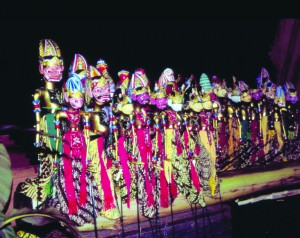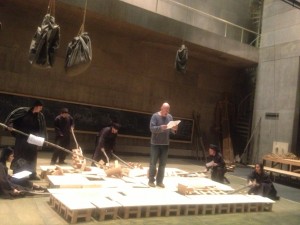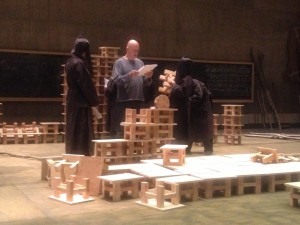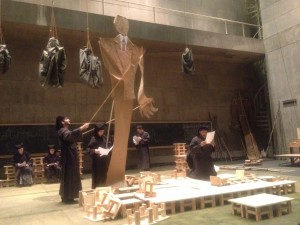Emma Gross ’15 reviews the “Sundanese & Javanese Puppet Plays,” performed on Saturday, April 27, 2013 at 8pm in World Music Hall as part of the Indonesian Performing Arts & Public Life Symposium, as well as “Music & Public Life,” a year-long campus and community-wide exploration, celebrating and studying the sounds, words, and spirit of music at the local, national, and transnational levels through concerts, workshops, gatherings, and courses, all designed to cross disciplines.

Gongs, xylophones, flutes, and drums of the Wesleyan Gamelan Ensemble sounded throughout the World Music Hall on Saturday April 27. As this traditional Indonesian orchestra played, spectators flocked to the building’s windows to get a better look at the show. A packed audience sat within the hall, enraptured by the performers—only one of whom was human.
The play was an Indonesian “wayang,” or puppet play. The event I attended Saturday night was the final installment of the Indonesian Performing Arts & Public Life Symposium. This celebration of Indonesian theater ran Thursday, April 25 to Saturday, April 27. It included speakers, performances, and demonstrations related to wayang, including a talk by guest puppeteer Kathy Foley, Professor of Southeast Asian Drama and Dance at the University of California Santa Cruz; Sarah Weiss, Associate Professor of Ethnomusicology at Yale University; Ronald Jenkins, Wesleyan University Professor of Theater; and Javanese musician, scholar, and Wesleyan University Professor of Music Sumarsam.
Saturday’s sold-out wayang featured two types of Indonesian puppet play: Sundanese “wayang golek” and Javanese “wayang kulit.” The Wesleyan Gamelan Ensemble, under the direction of Artist in Residence I.M. Harjito, provided the score for both acts.
The first segment showcased wayang golek, wooden doll puppets. Wayang golek are about a foot tall, and are operated by rods attached to the figures’ hands and running through their bodies. Each doll is embellished with intricate and elaborate costumes. Every puppet that performed in the show was clothed in vibrant colors and patterns; their bodies were detailed in gold, and their heads were carved with obvious care and precision into faces that could carry a range of emotional expression.
This spectacular ensemble of Sundanese figures performed a story from the “Babad Lokapala” cycle—the “prequel” to the “Ramayana,” describing how the demons and monkeys came to be. The audience sat cross-legged in the World Music Hall and watched, riveted, as the tale unfolded. This absolute viewer engagement speaks to the skill of the “dhalang,” or puppet master, Kathy Foley.
Ms. Foley was the sole puppeteer orchestrating the Sundanese “wayang golek.” She assumed the role of narrator, as well as the voice of every character. Ms. Foley endowed each puppet with distinctive mannerisms, gait, and speaking patterns. The entity and precise characteristics she brought to each figure succeeded in transporting the audience into the world at the front of the stage.
According to Ms. Foley, there are three character types in wayang golek: characters associated with adolescence, middle age, and as Ms. Foley describes, a final type that “represents our face as we approach our moment of death. They’re that part of us that screams, causes trouble, does everything else that’s sort of wild, and that we would love to forget.”
Together, these three character types performed a clever, engaging, moralistic, and comedic story. Ms. Foley maintained audience engagement not only through her adept puppet movement, voice inflection and facial expression, but also through her integration of humor into the narrative. At one point in the story, Ms. Foley remarked, “the monkeys, they sleep all day and stay up all night—just like Wesleyan students.”
At the end of the wayang golek act, audience members were treated to the Indonesian delicacy “lemper,” a dish made of glutinous rice filled with chicken. The lemper was homemade by a Middletown resident of Indonesian background, and distributed by Wesleyan students from Indonesia.
“The lemper was a delicious surprise,” remarked audience member Molly Steinfeld ‘15. “The evening was filled with introductions to various elements of Indonesian art and culture; the lemper added a tasty layer to this exploration.”
The second half of the show was dedicated to Javanese “wayang kulit,” or shadow puppets. “Kulit,” meaning skin, refers to the leather construction of the puppets. Each figure is carefully chiseled with fine tools and supported with carefully shaped buffalo horn handles and control rods. The shadows are cast on a cotton screen, and at Saturday’s performance, audience members were given the option of sitting on the viewing side of the puppets or the shadow side.
The dhalang for the second act was Wesleyan’s own Sumarsam, who told a story from the epic “Mahabharata.” The narrative involved a demon king, a guru in disguise, and a heavenly nymph. The plot, laden with desire, curses, comedy and confusion, was equally as enthralling as the Sundanese performance.
“The pace of a Javanese play is a lot more subdued than that of a Sundanese one,” explained Rizky Rahadianto ’15, a West Java native.
Mr. Rahadianto points to a key difference between the two acts. While the Sundanese puppets were constantly and vigorously moving—their gestures and dances were overstated and their voices were caricatures of the figures they portrayed—the Javanese figures were mostly stagnant; the incantation of their dialogue was slower, and the overall tone of the narrative felt calmer than that of the Sundanese.
Due to the more relaxed nature of wayang kulit and the viewer’s visual obstruction (caused by the cotton screen) from the characters, the audience’s engagement with the story is largely dependent on the expression of the dhalang.
“Sumarsam is an incredibly skilled dhalang,” commented Mr. Rahadianto. “His puppet movement and expression is perfectly executed. Sumarsam’s dialogue maintained the calm incantation of the Javanese wayang, but incorporated sharp social commentary and political humor, keeping viewers on their toes.”
Mr. Rahadianto was one of about ten Indonesian students in the audience at the performance Saturday night. “The last time I saw wayang was when I was in elementary school,” Mr. Rahadianto said. “Groups would come perform when we were younger, but never in middle or high school. This event allowed me to revisit part of my childhood. It was extremely nostalgic.”
Mr. Rahadianto explained that while wayang was popular when he was growing up, due to the influx of western television programming in Indonesian cities, there is less demand from young children today for puppet material. However, wayang continues to remain popular in more rural regions of Indonesia.
“I’m thrilled that Wesleyan made this opportunity available to its students and to the Middletown community,” said Mr. Rahadianto. “It’s a way to share and preserve Indonesian culture.”








